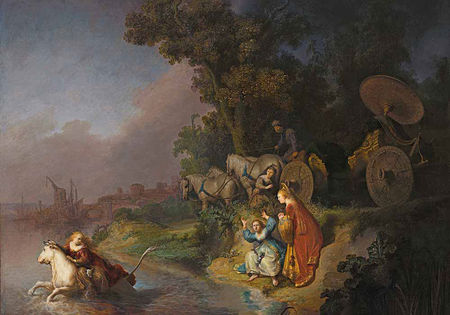« Rembrandt. Peintre d’histoires » au musée du Prado
Samson and Delilah. Oil on canvas, 206 x 276 cm 1636. Frankfurt, Städelsches Kunstinstitut und Städtische Galerie.
Rembrandt (1606-1669) is one of the most personal painters in the entire history of European art. From his beginnings in Leiden to his death in Amsterdam, his painting is a constant quest for representing human emotions as incisively and movingly as possible. This exhibition focuses on his biblical and historical paintings. On the scale of values of Rembrandt and his contemporaries, these were the most important themes a painter could address. They were also his best vehicle for showing how people reacted to dramatic situations and, accordingly, for exploring the human condition.
Bathsheba. Oil on canvas, 142 x 142 cm 1654. Paris, Musée du Louvre.
The exhibition features works from all the periods in Rembrandt’s career. In his early paintings, the gestures of the human figures are extroverted and their gaze is often mocking and jocular. In his mature works, the emotions are more suppressed and the emphasis is on their mental energy.
Jeremiah lamenting the Destruction of Jerusalem. Oil on panel, 58,3 x 46,6 cm 1630. Amsterdam, Rijksmuseum.
Rembrandt was familiar with the history of European painting through his huge print collection and the Amsterdam art market. Along with works by Rembrandt, the exhibition includes a few paintings by other artists, all from the Museo del Prado collection. The purpose of these works is to help viewers understand the Dutch painter. Some represent the aesthetic model that guided the painter or to which he reacted. Others are works by contemporaries whose difference from Rembrandt helps comprehend his particular aesthetic. Rembrandt’s art is firmly rooted in the European pictorial tradition. However, his attitude towards this tradition is critical: very few artists have been so determined to change it or have done so in such a radical manner.
The Rape of Europe. Oil on panel, 62,2 x 77 cm 1632. Los Angeles, CA, The J. Paul Getty Museum.
Rembrandt’s formative period began in Leiden in 1620 and ended when he moved to Amsterdam around 1631. By then he was a successful painter who had taken on his first pupils. There is no single style that characterises Rembrandt’s art during those years, but rather a variety of languages through which the painter sought to express the feelings of the main figures of his compositions.
The Apostle Bartholomew. Oil on canvas, 122.7 x 99.7cm 1657. San Diego, CA, The Timken Museum of Art.
A few of Rembrandt’s works from the late 1620s show the influence of Rubens (1577-1640), by then the most famous artist in Europe whose oeuvre he was familiar with chiefly through engravings. For over a decade, until approximately 1645, Rubens provided Rembrandt with both an artistic and a professional model to imitate, which spurred his ambition to become a great painter.
The Rest on the Flight into Egypt. Oil on panel, 34 x 48 cm. 1647. Dublin, National Gallery of Ireland.
When Rembrandt moved his studio from Leiden to Amsterdam around 1631-33, he did so as a partner of the dealer Hendrick Uylenburgh—whose niece Saskia he married in 1634; Uylenburgh sought out customers and the artist executed the pictures and directed a workshop of painters. Rembrandt soon became the most successful artist in the city. Although his fame initially stemmed from his splendid portraits (The Anatomy Lesson in the Museo Mauritshuis Museum in The Hague dates from this period), he also produced many history paintings, the most elite genre. Rembrandt was well versed in the history of European painting from the Renaissance onwards, chiefly through prints, of which he had a large collection. His painting reflects his knowledge of tradition and also his critical attitude towards it: he sought to emulate the great artists of the past, but also aspired to be a great painter with a language of his own.
Flora. Oil on canvas, 100 x 91,8 cm c. 1654. New York, The Metropolitan Museum of Art.
Rembrandt enjoyed his period of greatest success from his arrival in Amsterdam to approximately 1645. His engravings led his works to be widely disseminated across Europe. Constatijn Huygens’s support procured him commissions from the court of Frederik Hendrik of Orange and Amalia van Solms in The Hague, and he found clients among the haute bourgeoisie of Amsterdam. In 1639 he acquired an elegant, costly house in Sint Antonisbreestraat in Amsterdam. He finished painting The Night Watch (Amsterdam, Rijksmueum) in 1642 and his wife Saskia died that same year.
Artemisa. Oil on canvas, 143 x 154,7 cm 1634. Madrid, Museo Nacional del Prado
These are the years in which Rembrandt’s manner of painting comes closest to that of Rubens, whom he emulates without ceasing in his quest for a language of his own. In his paintings Rembrandt combines intensity and drama with a feeling of proximity, and revels in the textures of materials.
Two old Men disputing. Oil on panel, 2,4 x 59,7 cm Ca.1628. Melbourne, The National Gallery of Victoria.
Beginning in approximately 1645, a radical change can be witnessed in Rembrandt’s style. The extroverted expressions and dynamism of his compositions give way to calm and psychological concentration. The physical vigour that is characteristic of Rembrandt’s earlier human figures is transformed into spiritual vigour. In many areas of the paintings thick brushstrokes hint at forms rather than defining them. The importance Rembrandt attaches to an apparently unfinished execution in his final years is surprising. According to Arnold Houbraken (1660-1719), one of Rembrandt’s earliest biographers, the artist stated that “a painting is finished when the master has achieved his aims”. With this statement Rembrandt asserted his independence as a creator and also his belief that the aims of painting go beyond merely capturing the appearance of things.
Oil on canvas, 117 x 91 cm 1645. Saint Petersburg, State Hermitage Museum.

/https%3A%2F%2Fprofilepics.canalblog.com%2Fprofilepics%2F1%2F0%2F100183.jpg)
/https%3A%2F%2Fstorage.canalblog.com%2F03%2F02%2F119589%2F96711876_o.jpg)
/https%3A%2F%2Fstorage.canalblog.com%2F11%2F31%2F119589%2F94773502_o.jpg)
/https%3A%2F%2Fstorage.canalblog.com%2F20%2F83%2F119589%2F94772815_o.jpg)
/https%3A%2F%2Fstorage.canalblog.com%2F26%2F72%2F119589%2F75604929_o.jpg)
/https%3A%2F%2Fstorage.canalblog.com%2F59%2F60%2F119589%2F26458628_o.jpg)












/http%3A%2F%2Fstorage.canalblog.com%2F84%2F73%2F119589%2F128782095_o.jpeg)
/http%3A%2F%2Fstorage.canalblog.com%2F46%2F22%2F119589%2F122366228_o.jpg)
/http%3A%2F%2Fstorage.canalblog.com%2F56%2F77%2F119589%2F117688917_o.jpg)
/http%3A%2F%2Fstorage.canalblog.com%2F19%2F40%2F119589%2F112043921_o.jpg)